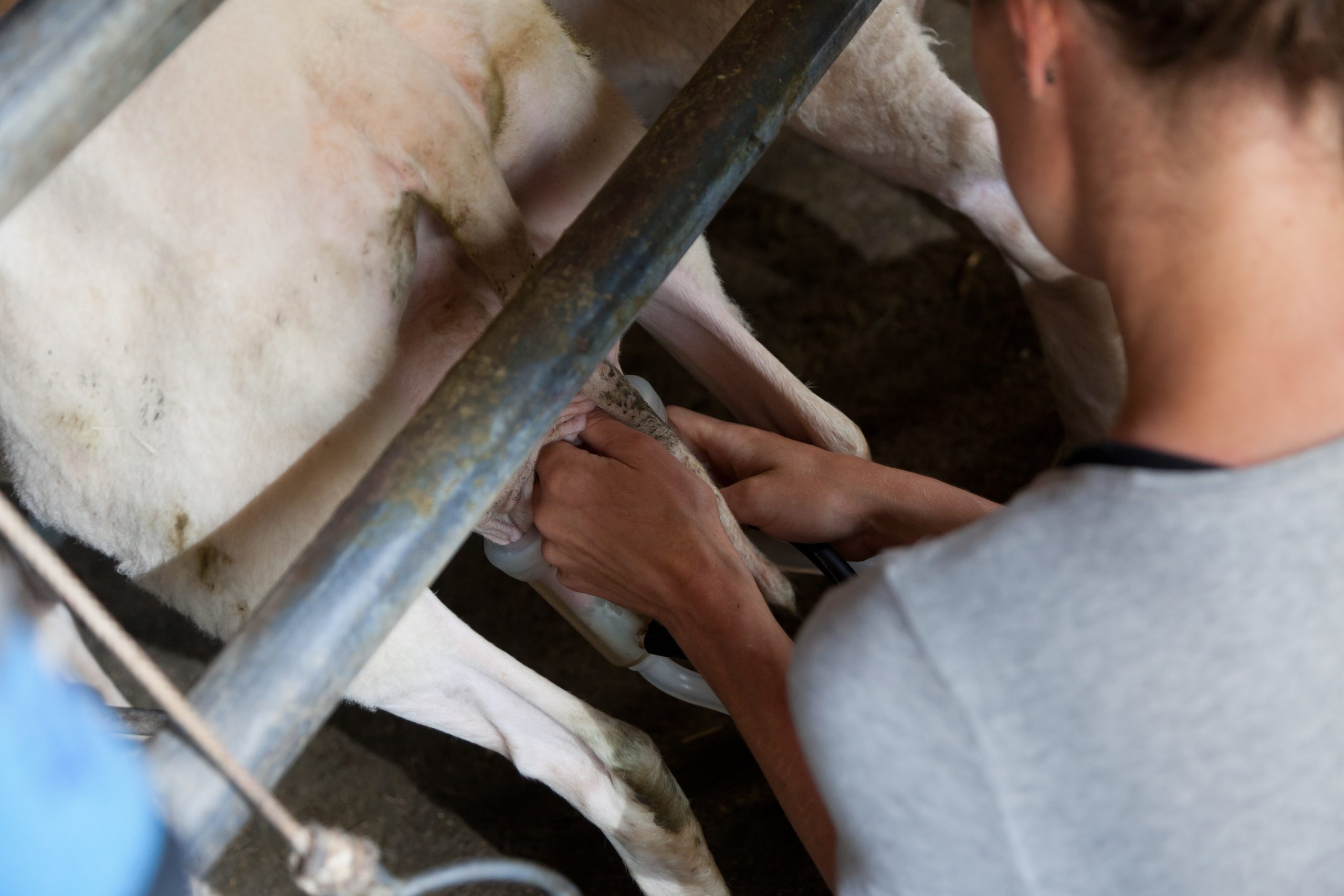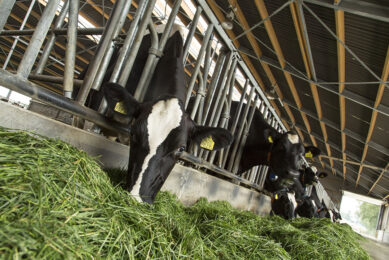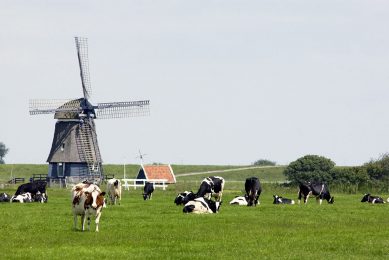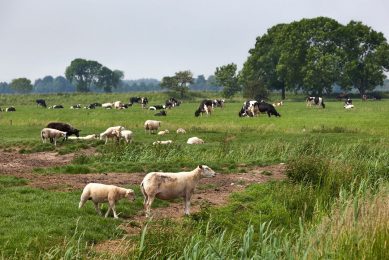Overcoming milk fat depression in grazing sheep

Dairy sheep farmers often struggle with getting the fat and protein percentages in balance. This is especially the case when the animals graze outside and forage consumption cannot be controlled.
The proportion of fat and protein in milk is primarily regulated by genetic factors but also by factors related to the breeding environment, management and nutrition. Sheep must be fed a minimum proportion (according to their body weight) of dry matter from forages. When this is not the case, it is directly reflected in the milk fat content.
Neutral detergent fibre (NDF)
The problem becomes more complicated for sheep that graze. These animals consume forages that are usually higher in structural carbohydrates and especially in neutral detergent fibre (NDF). The NDF content of grass increases towards the summer months, when the forages get drier. The NDF proportion is also different in different parts of the plant (leaves, stems etc.). So, at the time when pastures are green and rich in organic matter and moisture, the amount of validate fatty acids (VFA) produced in the rumen is different compared to sheep that are fed on dry hay grazing and animals that are reared indoors.
Seasonal fluctuations in milk fat %
In grazing units, it is not uncommon to see changes in the milk fat (%) during spring. Milk fat depression can also be observed in summer time and especially in countries with dry and humid conditions. Climate does not affect milk fat content directly but climate, dramatically depresses dry matter intake. Less dry matter means less fermentation so less production and absorption of VFAs from the rumen wall. For mountainous and semi-mountainous areas in countries like Cyprus, grazing is an important element and beneficial advantage for ruminants who can exploit these disadvantaged areas. Grazing is also an important asset to define the taste characteristics of milk-based products produced such as Halloumi cheese.
Effect of forage on rumen health
When you want to stabilise the milk fat (%) and protein (%) content according to the animal’s genetic potential, feed rations must provide consistent dry matter intake from forages and concentrates while maintaining a healthy and stable rumen fermentation capacity. Rumen flow rate is of high importance for grazing sheep as fresh green grass (higher in moisture) and green forages tend to rabidly ferment as they have a higher flow rate than hays and dry forages (higher in NDF).
Concentration of total dietary NDF affects rumen flow rate, dry matter intake, rumen pH and the amount of VFAs produced and absorbed through the rumen wall. On the other hand, non-structural carbohydrates (NSC) derived from cereals (corn, barley, etc.) often included in various concentrate types, increase the total percentage of propionic acid, from fermentation of starch and sugars. Acetic acid is used for the synthesis of fatty acids and is the main precursor to milk fat content. The production of sufficient levels of acetate is stimulated by the total dietary NDF and forages fermentation processes. Propionic acid is predominantly derived from total diet NSC and cereals fermentation, and is associated with milk lactose production and energy metabolism since it increases glucose synthesis in the liver.
Balance of diet ration
In sheep rations with simultaneous high use of cereal grains with minimal use of forages, the rumen environment tends to be more acetic and the concentration of lactic acid is increased. This increase reduces the rumen pH below 5.5, a sub-acute ruminal acidosis environment where NDF fermentation is dramatically reduced as bugs stop fermentative phenomena. Rumen bacteria fermenting NDF in acetic environment gradually reduces while the rumen wall is also getting thinner anatomically. The continuous absorption of lactic acid in the blood by the rumen epithelium is related to acidosis and other metabolic disorders such as sheep lameness. Also, acid load of the rumen can further depress dry matter intake. This situation describes exactly the reason why milk fat depression is the most critical problem for the average dairy sheep farmer while in an effort to increase milk production by feeding more concentrates. The issue is not the concentrates but the balance of the total diet ration, the proportion of forages to concentrates. Further to this, the use of various less soluble fatty acid-based products in the form of calcium salts is often recommended by individuals. These additives are of high energy density where this can limit also dry matter intake especially for sheep fed with imbalanced rations. It is good to use these types of products always under technical advice.

Protein and oils in the diet
The amount of crude protein of the ration and therefore the nitrogen consideration and the amount of sulfur-containing amino acids can also affect the activity of the rumen microbes, hence indirectly degradability of NDF and production of acetic acid. Another factor affecting rumen flow rate and NDF degradability are vegetable oils such as soybean oil and sunflower oil. Oils are often used in concentrates in order increase overall energy density and pellet quality. However, these oils are rich in unsaturated fatty acids. Fermentation of unsaturated fatty acids (UFAs) by rumen microflora is limited as all unsaturated and polyunsaturated (PUFAs) fats are hydrogenated in the rumen and absorbed as saturated fatty acids. This is because of UFAs and PUFAs antioxidant activity, that is toxic to rumen microflora. Caution must be given for their use in sheep diet rations in order not to block rumen functionality. In addition, steady feeding conditions are important. All productive animals regulate their functions of digestion and absorption of nutrients through the circadian rhythm, that is, a periodic rhythm within the 24-hour period.
Feeding frequency
Consequently, the stability of the diet in both terms of quality and quantity, as well as the feeding frequency are also critical for optimising nutrients absorption. Sheep tend to consume more feed during the day and ruminate more during the night. For this reason, the amount of milk milked in the morning is more in quantity but, in the afternoon, milk tends to be increased in fat content. Milk appears low milk fat (%) usually produced from sheep with a higher somatic cell count. This is an indication of subclinical and, in some cases, clinical mastitis often related and combined with nutritional imbalances, together with management issues.
Conclusion
The solution of maintaining a stable milk fat (%) and protein (%) balance in sheep milk according to genetic potential results from stabilising rumen fermentative phenomena. This is something that nutritional advisors and farmers have to work on together and create low cost forage consumption combined with the accurate use of more expensive concentrates. In that way grazing sheep can maintain milk production quality and quantity.
Author: Djionis Savva, Animal Feed Supervisor, Dodoni (Cyprus) Limited











